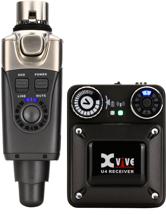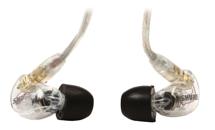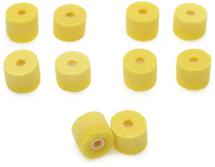In-Ear Monitors
Get More at Sweetwater
About In-Ear Monitors
The selection of in-ear monitoring at Sweetwater runs the gamut. We carry everything from earpieces to transmitters, receivers, and accessories. If you’re looking for professional in-ear monitors, Shure SE215s are a great place to start. These single-driver, lightweight in-ears connect to any 1/8-inch input, and they are surprisingly affordable.
What are in-ear monitors, and how do they work?
In-ear monitors (also known as IEMs or in-ears) represent a special category of headphones commonly used by live performers. But while traditional headphones deliver sound through earcups on the outer ear, in-ears deliver sound through tiny earpieces that fit into the ear canal. Because the earpieces of in-ear monitors slide into the ear, they create a barrier to any outside noise, offering 20-40dB of noise reduction.
While most in-ear monitors are designed for a universal fit, some professionals choose to invest in custom-made in-ear monitors. A molded impression of the individual’s ear canal is used to create perfectly tailored in-ears, offering the greatest possible comfort. The idea for custom-fitted in-ear monitors is actually credited to drummer Alex Van Halen and his former monitor engineer, Jerry Harvey. On a 1995 Van Halen tour, Alex was having trouble hearing other band members amid the overwhelming stage noise. When he voiced his frustration to the band’s monitor engineer, Jerry began tinkering. Tiny speakers - designed originally for pacemakers - were installed into earpieces molded from impressions of Alex’s ears, and voilà: Alex had the first-ever pair of custom in-ear monitors. The difference, in the drummer’s words, was like “night and day.”
What are the benefits of in-ear monitors?
Of course, in-ears can also be used outside of live venues. For instance, listeners rely on in-ear monitors in recording studios, radio stations, or even on their morning subway commute. But in-ear monitors’ discreet size and powerful isolation make them especially popular in the world of live performance. In settings where onstage monitors are unreliable, noisy, or visually distracting, in-ear monitors guarantee that musicians hear the mix they need to deliver the best possible live show. In-ear monitors do an incredibly effective job of blocking external noise such as audience applause, even at stadium shows. If musicians want to hear the audience, the mix engineer will position mics facing the crowd and send sound directly into the band’s in-ear monitors.
In short, in-ears take the guesswork out of live sound monitoring; they offer consistency, precision, and dependability to performers all over the world. And as an added benefit, in-ear monitoring gives artists total freedom and mobility onstage to walk anywhere.
Learn more in our In-ear Monitor Buying Guide.
How can I choose the best in-ear monitors for my needs?
Every artist's needs are different, which means you have options when picking the best IEMs for your application. Whether you're a guitarist needing live sound monitoring or you're outfitting a church worship system, Sweetwater can help. Here are the main points to consider when shopping in-ear monitors:
Driver Count
High-end IEMs can pack as many as eight micro drivers into a single earpiece! More is better, right? But unless you are buying a top-of-the-line monitoring system, you may be wondering how many you need to get the results you want. In this respect, the drivers in your IEMs are analogous to the number of speakers in a pair of studio monitors. With standard single-driver in-ears, the burden of re-creating the entire frequency spectrum rests squarely on one driver. While there are some truly impressive single-driver models out there, the fact is that there’s only so much a single driver can do, resulting in a limited frequency range, usually noticeable in the output of low-end frequencies.
When you step up to dual drivers per ear, your in-ear monitors start to resemble typical studio monitors. As with monitor speakers, these two drivers are separated by a passive crossover, allowing the full efficiency of one driver to go into reproducing low frequencies, while reserving the other for high frequencies. Add a third driver and a 3-way crossover into the mix, and you have a 3-way in-ear monitoring system with dedicated speakers for high, middle, and low frequencies - a combination that delivers deeper bass and greater clarity across the frequency spectrum. Every additional driver distributes the workload more broadly, allowing each to function more optimally.
Straight vs Over-ear IEMs
There are two basic configurations for in-ear monitors: the ones you stick in with cables that hang straight down, or the ones that wrap over the back of the ear. At the entry-level end of the spectrum, it’s all a matter of taste. Some people are initially uncomfortable with over-ear models, and there are a few high-quality straight in-ears to choose from. The over-ear configuration is more or less universally preferred by serious performers, given an over-ear configuration both secures your IEMs to your ears and hides the cables so they’re harder to spot. Once you step up to professional-grade and custom-molded IEMs, straight isn’t even an option anymore.
Foam vs Silicone Ear Tips
The vast majority of in-ear monitors offers you the choice of foam or silicone eartips, and they behave somewhat differently. Silicone eartips use suction to stay in place, which makes them great for active performers. They tend to be slightly less isolating than foam eartips, but many find the tradeoff for the added stability worth it and prefer their lighter feel. On the other hand, foam tends to be denser and more isolating, but the pressure they place on the ear canal can be uncomfortable, and they don’t handle sweat well. Many IEMs come with a sampler pack of eartips. For example, even the most basic Westones come with a full fit kit, including various sizes of both types of eartips. You can also buy a sample pack independent of the in-ears you have. While there are different inner diameters for various models, your Sweetwater Sales Engineer can help you find the right match for your favorite IEMs.
Custom vs Universal Fit
At Sweetwater, in-ear monitors and all things live sound are taken seriously. Our selection of universal fit IEMs is massive, but the benefit of getting custom-molded in-ears can’t be understated. Sweetwater’s exclusive Westone Customizer empowers you to pick the best in-ear monitors for your needs from an industry leader with over 50 years of developing IEM technology. Here’s how it works:
- Use the Westone Customizer to choose your model and specify colors and other options, and place your order.
- Your Sweetwater Sales Engineer will get in touch to confirm your order and provide you with information for the audiologist.
- Go to an audiologist (we’re happy to recommend one) to have your ear impressions made. They’ll send the impressions straight to Westone to complete your order.
Why shop in-ear monitors at Sweetwater?
With a massive selection of in-ear monitors, free shipping, a free 2-year warranty, 24/7 access to award-winning support - and more - Sweetwater gives you more than any other retailer! Shop in-ear monitors today or give your personal Sales Engineer a call at (800) 222-4700.












